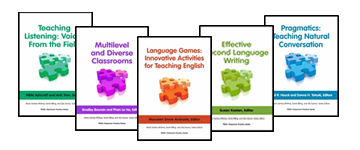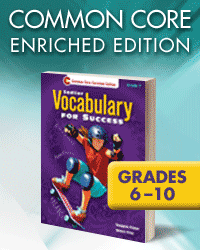Free Activities From New Ways in Teaching Vocabulary
The New Ways Series is a collection of activities and exercises for classroom practice. Here are three great activities for teaching reading from New Ways in Teaching Vocabulary.
Secret Word
|
Levels
Beginning
Adult |
Aims
Understand relationships between words and meanings |
|
Class Time
15–20 minutes
Preparation Time
10 minutes |
Resources
Small pieces of paper with the same word occurring on two separate pieces clipped together |
This game is a great deal of fun and can be used with any set of vocabulary. The idea is based on “Password,” a popular U.S. TV game show.
Procedure
-
Divide the students into pairs. In a large class, have two pairs play against each other. (Suggestions for doing this in a small group to follow.)
-
Give one student in each pair one of the pieces of paper. This person is the clue giver. The partner is the guesser. Thus, in each pair, one student has access to the word and one does not.
-
The two pairs (Students A, B, C, D) sit in a small group. Student A begins by giving a one-word clue to help B (the partner) say the word. After A says a clue, B has 5 seconds to guess. IF B is unsuccessful, then C will give a one-word clue to D. D has 5 seconds to guess. Continue until either B or D guesses the word. (Example: With the second word breakfast, clues could be eggs, meal, morning.)
-
If this activity is scored, one suggestion is to give 10 points if the word is guessed after the first clue, 9 points after the second, and so on. In other words, as more clues accumulate and it becomes easier to guess the secret word, the number of points decreases. In the next round, students B and D will be clue givers, A and C will be guessers.
Caveats and Options
-
In a small class, have two students take turns giving clues while all other students have to take turns guessing. This alternative is useful if you have an odd number of students.
-
It is important that students be limited to one-word clues. It should go without saying that no language but English should be used in this activity.
Contributor
Keith S. Folse is Principal at Language Academy, in Maebashi, Japan. He is the author of English Structure Practices, Intermediate Reading Practices, and Talk a Lot (University of Michigan Press).
Sorting Words as Review
|
Levels
Intermediate + |
Aims
Develop and extend semantic networks |
|
Class Time
20–30 minutes
Preparation Time
15 minutes |
Resources
List of items |
This activity helps learners remember the meanings of recently encountered lexical items. In a first step they are asked (indirectly) to examine the semantic network they have constructed for the item. The second step, which consists of comparison and discussion with other learners, serves to make them aware of gaps and misunderstandings as well as to extend their semantic networks. The activity can therefore be classified as a review exercise for “passive” control, in other words, for recognition and comprehension.
Procedure
- From the lexical items to be reviewed or recycled, select between 10 and 15 and either dictate them to the class or present them on the board or overhead projector.
- Ask the learners to think of three categories into which they could sort the words according to their meanings. It is up to them to decide on categories.
- When they have done this, they sit in small groups and compare categories and how they sorted the words, justifying their categories and discussing meanings. They discussion may be either in the L1 or L2, depending on class level.
Caveats and Options
- Give the categories as well as the words, but this is only interesting when it does not look like a test, that is, when there are a number of plausible sorting for learners to discuss afterwards. Here is an example. Let us say that the lexical items selected for review come from a reading text and subsequent discussion on physical fitness. They are:
|
daily exercise |
health clubs |
exercise facilities |
|
gym outfits |
stress |
consumer society |
|
equipment |
body building |
leisure time |
|
urban life |
aerobics |
advertising campaigns |
- After re-presenting the lexical items, ask the learners to sort them into categories labeled Luxury, Normal, and To be avoided. Another set of categories might be Expensive, Cheap, and Free. Categories like these introduce a new perspective and, at the same time, clearly indicate that sorting will depend on opinion and not fact.
- The small-group discussion after the sorting phase is essential because this is the time when the known meanings and connotations of the lexical items are discussed. The teacher will want to circulate among the groups, answering questions and listening for misunderstandings.
Contributor
Heather Murray teaches at Universität Bern in Switzerland.
The Story Behind the Picture
|
Levels
Intermediate + |
Aims
Use words in context |
|
Class Time
25 minutes
Preparation Time
10 minutes |
Resources
Picture
List of verbs |
Procedure
- Select an interesting picture, around which an unusual story could be developed.
- Give students a list of about 10 verbs to use in the story. Choose words that are a little unusual and not too obvious.
- Ask the students to work in groups and to develop a story around the picture, one that uses the words you have given them. Tell them their story should involve at least two people. They should make notes to use in telling their story. They must use all the words on the list at least once.
- Set a time limit. Then have a student from each group tell the group’s story. Other groups can ask questions. Which group has the best story?
Have groups write out their stories and attach them to the wall.
Contributor
Ronald Jackup is a freelance ESL teacher and writer.
________________________
These activities were originally published in New Ways in Teaching Vocabulary, published by TESOL.
Nation, P. (Ed.). (1994). New ways in teaching vocabulary. Alexandria, VA: Teachers of English to Speakers of Other Languages, Inc. (TESOL).
TC Monthly Giveaway Congratulations to Maureen Sargent of Nova Scotia, Canada, for being the winner of the August 2012 TESOL Connections Monthly Giveaway. Maureen won a free registration to a course in the TESOL Principles and Practices of Online Teaching certificate program.
This month, TESOL is giving away a free
Classroom Practice Book Set

Win three free books from TESOL's Classroom Practice Series.
You choose any three of the 15 books in the set!
Read about the books in
TESOL's Bookstore
Drawing closes 24 September 2012, at 11:59 pm, EST
Click here to enter
TESOL Blogs Interested in writing a blog for TESOL?
Contact Craig Triplett with your idea or for details.
Check out the latest TESOL Blogs:
|
$5.69 Professional Development, by Ayanna Cooper
 Welcome to the online discussion about Professional Development on a shoestring budget! When reflecting on Rehab Rajab’s article, "Building a Personal Learning Network (PLN) on a Budget," I thought a lot about the ways in which I participate in low cost professional development activities. I have to admit although I don’t have a Facebook, Twitter, or Linked In account (shocking – right?!) I do visit blogs, wikis, watch online webinars, and, most important, I value my Professional Learning Community. Rehab stated it best: “A PLN is . . . everyone and everything around us that we learn from.” With that definition in mind I’d like to describe a recent conversation I had with a colleague. Read More. Welcome to the online discussion about Professional Development on a shoestring budget! When reflecting on Rehab Rajab’s article, "Building a Personal Learning Network (PLN) on a Budget," I thought a lot about the ways in which I participate in low cost professional development activities. I have to admit although I don’t have a Facebook, Twitter, or Linked In account (shocking – right?!) I do visit blogs, wikis, watch online webinars, and, most important, I value my Professional Learning Community. Rehab stated it best: “A PLN is . . . everyone and everything around us that we learn from.” With that definition in mind I’d like to describe a recent conversation I had with a colleague. Read More.
|
TESOL Bookstore TESOL Books Help Teachers Meet the Challenge
in PRIMARY and SECONDARY Classrooms
Exemplary ESL, EFL, and classroom teachers share their experiences and offer numerous insightful classroom success stories for the educational achievement of English language learners.
Order from the TESOL Online Bookstore
Or contact tesol@brightkey.net
|
 |
|
|
 |
| Executive Coordinator, Oregon State University, Corvallis, Oregon, USA
ESL Specialist, American Language Institute, Toledo, Ohio, USA
Academic Director, EF Education First, Atlanta, Georgia, USA
Want to post your open positions to Job Link? Click here.
To browse all of TESOL's job postings, check out the TESOL Career Center. |
 |
|
 |
| ADVERTISEMENT |

|
 |
|